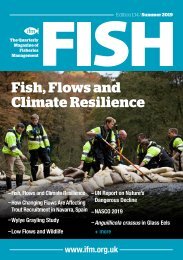FISH 133 Spring 2019
The members magazine from the Institute of Fisheries Management
The members magazine from the Institute of Fisheries Management
Create successful ePaper yourself
Turn your PDF publications into a flip-book with our unique Google optimized e-Paper software.
The white gold rush<br />
Patagonian toothfish, with their buttery white<br />
flesh and a mild, non-fishy flavour were seen as<br />
ideal fish to exploit, though their appearance and<br />
name was seen as less appetising so they were<br />
rebranded as Chilean sea bass, Chilean grouper<br />
and black hake. In Japan it is known as mero.<br />
In Chile it is known as bacalao de profundidad or<br />
merluza negra.<br />
With this ‘rebranding’ of the Patagonian toothfish,<br />
it wasn’t long before it was gracing the tables of<br />
upscale seafood restaurants around the world.<br />
With demand and prices surging, the white gold<br />
rush began in earnest.<br />
In the mid-1980s, industrial fishing fleets from<br />
Spain, South Korea and Japan, which had<br />
overfished their national waters and depleted fish<br />
stocks in Chilean waters, then joined in the rush<br />
to target the Patagonian toothfish.<br />
By 1994, fishing for Patagonian toothfish spread<br />
to the coast of Argentina. Illegal, or pirate, fishing<br />
for toothfish was rampant. In some areas up<br />
to 90 percent of the total Patagonian toothfish<br />
catch was being taken by illegal, unreported, and<br />
unregulated (IUU) long-line fishers. In 1997 the<br />
estimated illegal catch of Patagonian toothfish<br />
was around 70,000 tonnes with a value of over<br />
$500 million.<br />
Different tactics were being used by illegal traders<br />
to introduce illegally caught toothfish into the<br />
United States market, including: mislabelling;<br />
laundering illegally caught toothfish through the<br />
Commission for the Conservation of Antarctic<br />
Marine Living Resources’s (CCAMLR) own Catch<br />
Documentation Scheme; using ports with lax<br />
controls and dubious flag states; tampering with<br />
the Vessel Monitoring Systems; misreporting<br />
catches (i.e., claiming that catches were taken<br />
on the high seas, even though they were caught<br />
in CCAMLR waters); exploiting gaps in the chain<br />
of custody; and trans-shipment of the fish at port<br />
and at sea.<br />
The fish on your dinner plate may be<br />
an endangered species<br />
In a report by Oceana in 2016, it was not<br />
uncommon to find threatened and endangered<br />
fish being passed off as either from legitimate<br />
sources or passed off as other species in markets<br />
around the world.<br />
The authors found fraud at every level of the<br />
seafood supply chain, from distribution to retail.<br />
One in five of the more than 25,000 samples<br />
tested was found to be mislabelled, on average,<br />
and researchers discovered fraud in every area<br />
studied except one. In the United States on<br />
average 28 percent of fish were labelled as<br />
another fish with fish labelled snapper, grouper,<br />
and salmon being the least likely to actually be<br />
those types of fish. In Europe, hake and sole<br />
were mislabelled the most. Sixteen percent of<br />
the fish mislabelled as other species were found<br />
to have some level of conservation risk.<br />
The edge of collapse<br />
© Tony Fitzsimmons MSC<br />
From the early 2000s catches of Patagonian<br />
toothfish began to collapse as the stocks<br />
were being over-exploited by both legal and<br />
illegal fishing.<br />
As the fishery floundered, the foodservice<br />
industry began to have second thoughts and<br />
the US based ethical supermarket chain Whole<br />
Foods Market halted sales and more than 700<br />
US chefs joined forces with environmental groups<br />
on the “Take a pass” campaign. Toothfish was<br />
now off the menu.<br />
The fishery was killing albatrosses<br />
and petrels<br />
The Patagonian toothfish fishery uses longlines,<br />
which were killing an estimated 100,000<br />
albatrosses each year. The frozen bait used<br />
by the fishery floated on the surface until it<br />
thawed and the birds dived to take the bait,<br />
became hooked and were then dragged below<br />
9<br />
The Plight of Patagonian Toothfish





